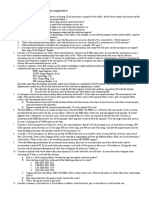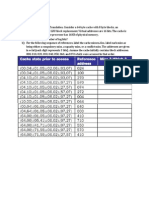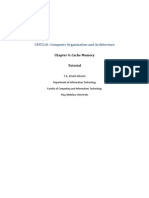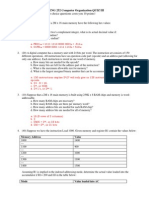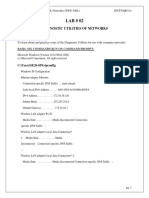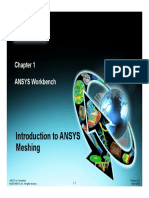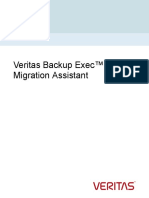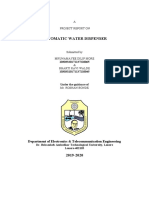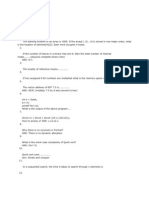Problem Set 2
Problem Set 2
Uploaded by
bijan shresthaCopyright:
Available Formats
Problem Set 2
Problem Set 2
Uploaded by
bijan shresthaOriginal Description:
Copyright
Available Formats
Share this document
Did you find this document useful?
Is this content inappropriate?
Copyright:
Available Formats
Problem Set 2
Problem Set 2
Uploaded by
bijan shresthaCopyright:
Available Formats
B.
Tech(CSE) – Computer Architecture and Organization – CSE2001 – Fall 2016
Problem Set
1. Perform the division of (117) ÷ (-9) using Restoring and Non restoring division algorithm.
2. Show the contents of registers E, A, Q and SC during the process of multiplication of two
binary numbers, 11111 (multiplicand) and 10101 (multiplier) using Booths Algorithm.
3. Show step by step process of modified booth multiplication algorithm with the flowchart
for 15 x -13.
4. Give examples for the following four different cases (i) carry, overflow (ii) no carry,
overflow (iii) carry, no overflow (iv)no carry, no overflow.
5. Give the algorithm for Non restoring division and perform the same on (27) ÷ (-6)
6. How do you determine the overflow in each of the representations? (i) signed magnitude
addition and subtraction (ii) two's complement addition and subtraction (iii) unsigned
addition and subtraction? Illustrate each case with an example.
7. Give the algorithm for 2’s complement addition and subtraction and perform the same on
1011111 + 0101101.
8. Compare and contrast Booth with modified booth multiplication Algorithm.
9. Represent -35 and 75 in a) Sign magnitude b) ones complement c) twos complement
format.
10. State and prove the Bit pair recording table of modified Booths Algorithm.
11. Represent +12.456 in single precision IEEE 754 format.
12. Represent – 23.543 in double precision IEEE 754 format.
13. Determine the value of 1 10101011 11100101000000000000000 in decimal.
14. Determine the value of
0 11101011010 1110101010000000000000000000000000000000000000000000
15. For the hexadecimal main memory addresses 111111, 666666,BBBBBB, show the
following information, in hexadecimal format:
a. Tag, Line, and Word values for a direct-mapped cache, where tag – 8bits, line
– 14 bits, word – 2 bits
b. Tag and Word values for an associative cache, where tag – 22 bits, word – 2
bits
Dr. Saritha V, Associate Professor, Scope, VIT University page. 1
B.Tech(CSE) – Computer Architecture and Organization – CSE2001 – Fall 2016
c. Tag, Set, and Word values for a two-way set-associative cache, where tag – 9
bits, set – 13 bits, word – 2 bits
16. List the following values:
d. For the direct cache from the below Fig: address length, number of
addressable units, block size, number of blocks in main memory, number of
lines in cache, size of tag
e. For the associative cache from below Figure: address length, number of
addressable units, block size, number of blocks in main memory, number of
lines in cache, size of tag
f. For the two-way set-associative cache example of Figure 4.15: address length,
number of addressable units, block size, number of blocks in main memory,
number of lines in set, number of sets, number of lines in cache, size of tag
17. Consider a 32-bit microprocessor that has an on-chip 16-KByte four-way set-
associative cache. Assume that the cache has a line size of four 32-bit words. Draw a
block diagram of this cache showing its organization and how the different address
fields are used to determine a cache hit/miss. Where in the cache is the word from
memory location ABCDE8F8 mapped?
18. Consider a machine with a byte addressable main memory of 216 bytes and block
size of 8 bytes. Assume that a direct mapped cache consisting of 32 lines is used with
this machine.
g. How is a 16-bit memory address divided into tag, line number, and byte
number?
h. Into what line would bytes with each of the following addresses be stored?
0001 0001 0001 1011
1100 0011 0011 0100
1101 0000 0001 1101
1010 1010 1010 1010
i. Suppose the byte with address 0001 1010 0001 1010 is stored in the cache.
What are the addresses of the other bytes stored along with it?
j. How many total bytes of memory can be stored in the cache?
k. Why the tag is also stored in the cache?
Dr. Saritha V, Associate Professor, Scope, VIT University page. 2
B.Tech(CSE) – Computer Architecture and Organization – CSE2001 – Fall 2016
19. A set-associative cache has a block size of four 16-bit words and a set size of 2.
The cache can accommodate a total of 4096 words. The main memory size that is
cacheable is 64K × 32 bits. Show how the processor’s addresses are interpreted?
20. Consider a memory system that uses a 32-bit address to address at the byte level,
plus a cache that uses a 64-byte line size.
l. Assume a direct mapped cache with a tag field in the address of 20 bits. Show
the address format and determine the following parameters: number of
addressable units, number of blocks in main memory, number of lines in
cache, size of tag.
m. Assume an associative cache. Show the address format and determine the
following parameters: number of addressable units, number of blocks in main
memory, number of lines in cache, size of tag.
n. Assume a four-way set-associative cache with a tag field in the address of 9
bits. Show the address format and determine the following parameters:
number of addressable units, number of blocks in main memory, number of
lines in set, number of sets in cache, number of lines in cache, size of tag.
21. Consider a computer with the following characteristics: total of 1Mbyte of main
memory; word size of 1 byte; block size of 16 bytes; and cache size of 64 Kbytes.
o. For the main memory addresses of F0010, 01234, and CABBE, give the
corresponding tag, cache line address, and word offsets for a direct-mapped
cache.
p. Give any two main memory addresses with different tags that map to the same
cache slot for a direct-mapped cache.
q. For the main memory addresses of F0010 and CABBE, give the corresponding
tag and offset values for a fully-associative cache.
r. For the main memory addresses of F0010 and CABBE, give the corresponding
tag, cache set, and offset values for a two-way set-associative cache.
22. Consider the following code:
for (i = 0; i < 20; i++)
for ( j = 0; j < 10; j++)
a[i] = a[i] * j
a. Give one example of the spatial locality in the code.
b. Give one example of the temporal locality in the code.
23. Consider a memory system with the following parameters:
Tc = 100ns; Tm = 1200ns
If the effective access time is 10% greater than the cache access time, what is the hit
ratio H for look through cache?
24. Consider a look through cache with an access time of 1 ns and a hit ratio of H
0.95. Suppose that we can change the cache design (size of cache, cache organization)
such that we increase H to 0.97, but increase access time to 1.5 ns. What conditions
must be met for this change to result in improved performance?
25. A computer employs RAM chips of 128 x 8 and ROM chips of 512 x 8. The
computer system needs 256 *16 of RAM, 1024 x 16 of ROM, and two interface units
with 256 registers each.
Dr. Saritha V, Associate Professor, Scope, VIT University page. 3
B.Tech(CSE) – Computer Architecture and Organization – CSE2001 – Fall 2016
Show the chip layout for the given specifications.
26. A computer employs RAM chips of 128 x 8 and ROM chips of 512 x 8. The
computer system needs 512 *8 of RAM, 512 x 16 of ROM, and two interface units
with 256 registers each.
Show the chip layout for the given specifications.
27. If the received data is 101110011001. Determine whether single bit error or more
than one bit error occurs. If there is an error in single bit, perform error correction.
28. If the received data is 001101100111. Determine whether single bit error or more
than one bit error occurs. If there is an error in single bit, perform error correction.
29. Calculate the check bits for the data bits 101100110101.
30. Compare the performance of FIFO, LRU and optimal page replacement
algorithms in terms of hit ratio considering three pages to be in memory at a time for
the following sequence.
2 3 2 1 5 2 4 5 3 2 5 2
Dr. Saritha V, Associate Professor, Scope, VIT University page. 4
You might also like
- In Company 3 0 b2 Upper Intermediate Student S Book PDFDocument162 pagesIn Company 3 0 b2 Upper Intermediate Student S Book PDFGiovanna Morgero97% (29)
- Microsoft 70 740Document141 pagesMicrosoft 70 740Tanvir AhmedNo ratings yet
- Cache Memory ProblemsDocument3 pagesCache Memory Problemsa100% (1)
- BT Cache deDocument4 pagesBT Cache deLe Chanh Thanh TinNo ratings yet
- Assignment Number3Document3 pagesAssignment Number3Ahmed GamalNo ratings yet
- Princes Nourah University Cs323-Computer Architecture 1 Semester/ 1435Document6 pagesPrinces Nourah University Cs323-Computer Architecture 1 Semester/ 1435Urwa NaveedNo ratings yet
- Tutorial Sheet For Slow Learners.: CSE2001: Computer Architecture and OrganizationDocument2 pagesTutorial Sheet For Slow Learners.: CSE2001: Computer Architecture and OrganizationSuman SharmaNo ratings yet
- Extra Exercise Chapter 4 Cache MemoryDocument11 pagesExtra Exercise Chapter 4 Cache MemorySundari MuthuNo ratings yet
- Computer Architecture and Organization Assignment IIDocument2 pagesComputer Architecture and Organization Assignment IIDEMEKE BEYENENo ratings yet
- Model Answers HW3Document5 pagesModel Answers HW3John100% (2)
- TutorialModule5 Part1 AnswersDocument8 pagesTutorialModule5 Part1 AnswersHilario Naranjo Hernandez100% (1)
- COA QuestionsDocument12 pagesCOA QuestionsSugoto Basu100% (1)
- Cache Data Size: 32 Kib Cache Block Size: 2 Words Cache Access Time: 1 CycleDocument2 pagesCache Data Size: 32 Kib Cache Block Size: 2 Words Cache Access Time: 1 CycleĐức TàiNo ratings yet
- الواجبDocument4 pagesالواجبBasma Mohamed ElgNo ratings yet
- Fallsem2019-20 Cse2001 TH VL2019201000616 Da-2 Quiz-1 QP Key Da2 PDFDocument3 pagesFallsem2019-20 Cse2001 TH VL2019201000616 Da-2 Quiz-1 QP Key Da2 PDFBadhan PaulNo ratings yet
- Problem CacheMemory1Document9 pagesProblem CacheMemory1buulaaatNo ratings yet
- Log Log 64 6: ThelineDocument5 pagesLog Log 64 6: ThelineBantos BenNo ratings yet
- FALLSEM2019-20 CSE2001 TH VL2019201007433 Reference Material I 18-Sep-2019 DA-2Document2 pagesFALLSEM2019-20 CSE2001 TH VL2019201007433 Reference Material I 18-Sep-2019 DA-2Sachin KharelNo ratings yet
- FALLSEM2019-20 CSE2001 TH VL2019201007433 Reference Material I 18-Sep-2019 DA-2 PDFDocument2 pagesFALLSEM2019-20 CSE2001 TH VL2019201007433 Reference Material I 18-Sep-2019 DA-2 PDFSubarna Lamsal0% (1)
- BaiTap Chuong4 PDFDocument8 pagesBaiTap Chuong4 PDFtrongbang108No ratings yet
- Co QSTN BankDocument4 pagesCo QSTN Bankjoydeep12No ratings yet
- Cache SolutionsDocument6 pagesCache SolutionsKannan KaruppiahNo ratings yet
- CO261-GroupB 22112021 With SolutionsDocument5 pagesCO261-GroupB 22112021 With SolutionsbilCHaNo ratings yet
- Problems Memory HierarchyDocument27 pagesProblems Memory HierarchyCruise_IceNo ratings yet
- Chapter 4 - Tutorial3Document6 pagesChapter 4 - Tutorial3Erwan Christo Shui 廖No ratings yet
- Memorys NumericalDocument11 pagesMemorys NumericalAman KumarNo ratings yet
- Module 4 - Cache Memory ProblemsDocument8 pagesModule 4 - Cache Memory Problemssomesh.tg2023No ratings yet
- Chapter 4.: Ex. 1. Caches and Address Translation. Consider A 64 Byte Cache With 8 Byte Blocks, An Associativity ofDocument8 pagesChapter 4.: Ex. 1. Caches and Address Translation. Consider A 64 Byte Cache With 8 Byte Blocks, An Associativity ofthanhspy007No ratings yet
- COA-Final Exam-2011Document2 pagesCOA-Final Exam-2011mulugetahiluf995No ratings yet
- Computer Architecture Sample FinalDocument10 pagesComputer Architecture Sample Finalkhayat_samirNo ratings yet
- Computer OrganizationDocument9 pagesComputer OrganizationNur Syahira YusraNo ratings yet
- HW6Document3 pagesHW6Christopher LopezNo ratings yet
- ETE Practice Questions Set - 2Document2 pagesETE Practice Questions Set - 2Nikhil PatelNo ratings yet
- Coa Assignment On CacheDocument4 pagesCoa Assignment On CachesamarNo ratings yet
- Computer Organization Jan 2010 OLDDocument1 pageComputer Organization Jan 2010 OLDPrasad C MNo ratings yet
- Assignment 3 Computer Organization & ArchitectureDocument2 pagesAssignment 3 Computer Organization & ArchitectureHimanshu GuptaNo ratings yet
- Assignment 1 PDFDocument2 pagesAssignment 1 PDFAditya MathurNo ratings yet
- Sheet 5Document10 pagesSheet 5anoop_383575% (8)
- CSNB123 - Tutorial CSNB123 - TutorialDocument7 pagesCSNB123 - Tutorial CSNB123 - TutorialMuhd Izzuddin Abd RazakNo ratings yet
- MCS 012Document4 pagesMCS 012rajatkumar.codingNo ratings yet
- L6 QnewDocument12 pagesL6 Qnewslama0378No ratings yet
- Ca Uinit4Document3 pagesCa Uinit4CSETUBENo ratings yet
- Computer Organization - List of Assignments.Document7 pagesComputer Organization - List of Assignments.arnab_bhattacharj_26No ratings yet
- Tutorial 7cacheDocument2 pagesTutorial 7cacheSasuke UchihaNo ratings yet
- Co AssDocument2 pagesCo Assshivam agrawalNo ratings yet
- Ceng252 Quiz3answersDocument3 pagesCeng252 Quiz3answersVenkata Krishnamraju Kalidindi100% (2)
- Exercise 5_with solutionDocument8 pagesExercise 5_with solutioncelestemelodyNo ratings yet
- Numerical QuestionsDocument1 pageNumerical QuestionsVaibhav ChaudharyNo ratings yet
- CRC of BCA (2) Assignment (Revised Syllabus)Document17 pagesCRC of BCA (2) Assignment (Revised Syllabus)BshrinivasNo ratings yet
- 5_6109587761629499216Document14 pages5_6109587761629499216Fatin FanisyaNo ratings yet
- Tutorial 8Document6 pagesTutorial 8Nixon GamingNo ratings yet
- COA Assignment: This Assignment Consists of 10 Questions. Each Question Is of 5 MarksDocument3 pagesCOA Assignment: This Assignment Consists of 10 Questions. Each Question Is of 5 Marksprakhar agrawalNo ratings yet
- Topic 5 Tutorial SolutionsDocument4 pagesTopic 5 Tutorial SolutionsSaimo MghaseNo ratings yet
- hw6 CircuitsDocument4 pageshw6 Circuitsayylmao kekNo ratings yet
- BCA 2nd Sem Ass.2018-19Document15 pagesBCA 2nd Sem Ass.2018-19Kumar InfoNo ratings yet
- CS704 Finalterm QA Past PapersDocument20 pagesCS704 Finalterm QA Past PapersMuhammad MunirNo ratings yet
- Coa SolutionDocument2 pagesCoa Solutionnandini sharmaNo ratings yet
- Solutions To Exercises On Memory ManagementDocument7 pagesSolutions To Exercises On Memory ManagementLộc SẹoNo ratings yet
- Introduction to Computer Organization: An Under the Hood Look at Hardware and x86-64 AssemblyFrom EverandIntroduction to Computer Organization: An Under the Hood Look at Hardware and x86-64 AssemblyNo ratings yet
- Essentials of Compilation: An Incremental Approach in RacketFrom EverandEssentials of Compilation: An Incremental Approach in RacketNo ratings yet
- AP Computer Science Principles: Student-Crafted Practice Tests For ExcellenceFrom EverandAP Computer Science Principles: Student-Crafted Practice Tests For ExcellenceNo ratings yet
- Organization of Multiprocessor SystemsDocument87 pagesOrganization of Multiprocessor Systemsbijan shresthaNo ratings yet
- Io Module5Document80 pagesIo Module5bijan shresthaNo ratings yet
- DLD Module 7 PrintDocument13 pagesDLD Module 7 Printbijan shresthaNo ratings yet
- DLD Module 7Document19 pagesDLD Module 7bijan shresthaNo ratings yet
- PerformanceDocument12 pagesPerformancebijan shresthaNo ratings yet
- Io OrganizationDocument20 pagesIo Organizationbijan shresthaNo ratings yet
- What Is "Datapath"?Document15 pagesWhat Is "Datapath"?bijan shresthaNo ratings yet
- YEA-SIA-IEC-4 - Hardware Configuration - 2013-03-26 PDFDocument165 pagesYEA-SIA-IEC-4 - Hardware Configuration - 2013-03-26 PDFadolfoNo ratings yet
- LWC 4Document12 pagesLWC 4Suresh KumarNo ratings yet
- ElsaWin 4.0 Installation ENUDocument38 pagesElsaWin 4.0 Installation ENUsdfasdfNo ratings yet
- CHAPTER 1-Introduction To Computer (Module)Document19 pagesCHAPTER 1-Introduction To Computer (Module)NSBMRNo ratings yet
- Microsoft .NET SDK 8.0.106 (x64) 20240710131539 017 Dotnet Runtime 8.0.6 Win X64.msiDocument62 pagesMicrosoft .NET SDK 8.0.106 (x64) 20240710131539 017 Dotnet Runtime 8.0.6 Win X64.msic bitzyNo ratings yet
- Linux Installation - GuideDocument9 pagesLinux Installation - GuideLUIS GERARDO ROSAS ECHEVERRYNo ratings yet
- Lab No.2 CCNDocument6 pagesLab No.2 CCNMaham AkramNo ratings yet
- SuruchiBhatnagar (4 6) PDFDocument3 pagesSuruchiBhatnagar (4 6) PDFChandra Sekhar DNo ratings yet
- CH 22 - Problem Spaces and SearchDocument18 pagesCH 22 - Problem Spaces and SearchVijaya Prakash RajanalaNo ratings yet
- IoT Based Raspberry Pi Home Automation ProjectDocument18 pagesIoT Based Raspberry Pi Home Automation ProjectageesNo ratings yet
- Bizhub 4052 BEU en ScreenDocument7 pagesBizhub 4052 BEU en Screenxtenbagiu93No ratings yet
- Introduction To ANSYS Introduction To ANSYS MeshingDocument15 pagesIntroduction To ANSYS Introduction To ANSYS Meshingumair35No ratings yet
- Display "Hello World"message Using Internal UARTDocument16 pagesDisplay "Hello World"message Using Internal UARTAkshathaNo ratings yet
- M4 SP Flash Tool Guidance V1.0 PDFDocument12 pagesM4 SP Flash Tool Guidance V1.0 PDFkomander apodacaNo ratings yet
- TAS SrsDocument8 pagesTAS SrsRishabh MauryaNo ratings yet
- Data Transfer and Manipulation PDFDocument2 pagesData Transfer and Manipulation PDFVishant ChaudharyNo ratings yet
- MCP 9804Document54 pagesMCP 9804Nikola NikolicNo ratings yet
- Parallel Processing ReportDocument9 pagesParallel Processing ReportZaidBNo ratings yet
- Self-Guided Zotero Tutorial - PublicDocument75 pagesSelf-Guided Zotero Tutorial - PublicMaroof HamidNo ratings yet
- OSS OverviewDocument79 pagesOSS OverviewHedayatullah NiaziNo ratings yet
- Veritas Backup Exec Migration AssistantDocument21 pagesVeritas Backup Exec Migration AssistantArunMuraliNo ratings yet
- Report ProjectDocument20 pagesReport ProjectSakshi GosaviNo ratings yet
- IT Workshop IntroductionDocument11 pagesIT Workshop Introductionmaruthi631No ratings yet
- Unit 2. The Parts of A CompilerDocument24 pagesUnit 2. The Parts of A CompilerHuy Đỗ QuangNo ratings yet
- Soa Whitepaper UpdatedDocument15 pagesSoa Whitepaper UpdatedSuparna DasNo ratings yet
- Tle 10 AldoDocument27 pagesTle 10 Aldokirusan804No ratings yet
- CiscoDocument30 pagesCiscoAnurag MishraNo ratings yet
- Overview of C Language Question and AnswerDocument5 pagesOverview of C Language Question and AnswerRathindra Nath MohalderNo ratings yet








